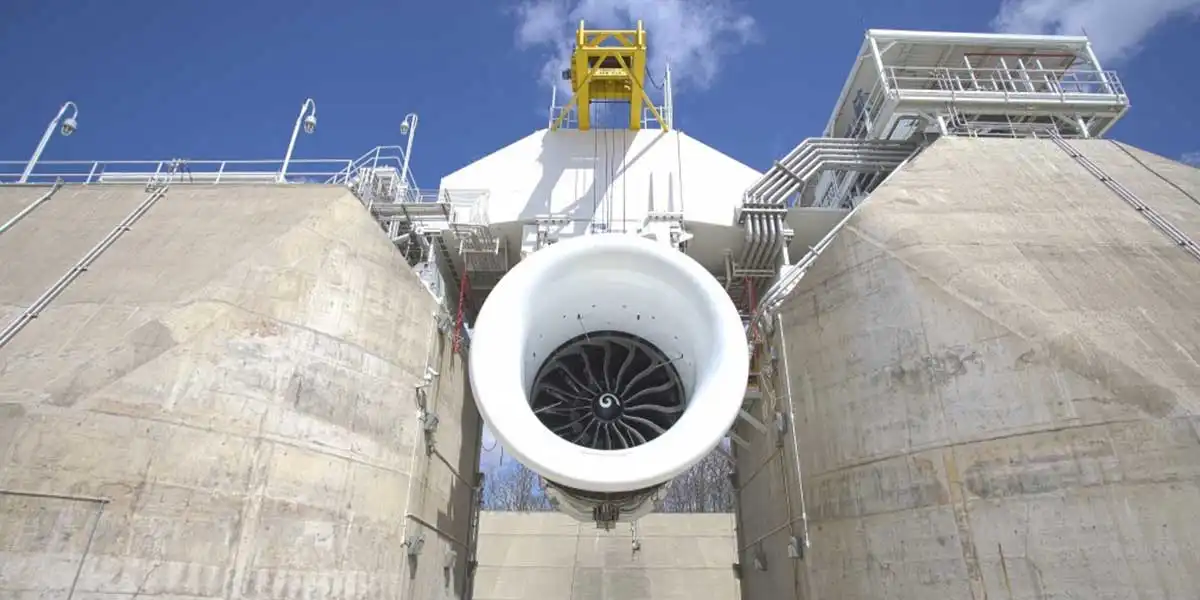In 1903, the Wright Brothers made the first controlled, powered and sustained flight using a four-cylinder engine with an aluminum crankcase. The flyer's propellers, 8 feet in diameter, were made from spruce. Its ribs were constructed of two thin strips of ash with small blocks in between.
Allowing 200 pounds for the propulsion system, the brothers estimated the weight of their airplane, with pilot, at 625 pounds.
A reasonable weight, it seems, considering the Wright siblings didn't have the benefit of ceramic matrix composite (CMC) components when building their engine. With one-third the density of metal alloys and greater thermal capabilities, CMC components reduce an engine's overall weight for improved fuel efficiency, engine performance and durability.
By contrast, the world's largest commercial aircraft engine makes extensive use of lightweight, ultra heat-resistant CMC components in its design.
Meet the GE9X engine, the newest, biggest kid on the engine block. Designed by General Electric Aviation, the engine will power Boeing's new 777X aircraft. The GE9X's front fans span 11 feet in diameter, while its inlet duct measures 18 feet by 12 feet. Put it this way: Shaq could stand inside with Kobe sitting on his shoulders and have room to walk around.
The engine's 16 carbon-fiber fan blades, thinner and lighter than its predecessors, enhance the airflow and make for a lighter, more efficient fan. The fan case also utilizes carbon fiber composites to reduce the engine’s weight by almost 400 pounds.
CMCS A CRITICAL PATHWAY ON GE AVIATION’S TECHNOLOGY ROADMAP
The aerospace industry represents one of the most important field of application for
ceramic and carbon matrix composites. The materials offer outstanding thermal protection properties, high-temperature resistance, wear-resistant characteristics, and resistance to extreme environments.
Carbon matrix composites, as used in the GE9X's fan blades, find application in the production of aircraft interiors, aircraft brakes, components for atmospheric reentry vehicles, rocket nozzles, and so on.
GE Aviation claims the use of CMCs in the hot section of its jet engines is a breakthrough for the jet propulsion industry. CMCs operate in temperatures as high as 2,400 degrees Fahrenheit. The material, used inside the combustor and the turbine, allows engineers to keep the heat higher inside the engine while reducing fuel burn and emissions, the company
reports.
Since CMCs are far more heat resistant than metal alloys, they require less cooling air in the engine’s hot section. This air instead can be used in the engine flow path, enabling it to run more efficiently. Also, this allows engines to stay on wing longer. The material requires 20 percent less cooling air, which improves overall engine efficiency.
“The hotter the engine runs, the more efficient it is,”
says GE Aviation spokesman Rick Kennedy.
In October, GE Aviation completed initial
ground testing of the engine, which accumulated 167 hours, 213 cycles and 89 starts during the assessment. The testing provided data on the engine’s aero and thermal characteristics, mechanical integrity, performance and operability.
Later this year, GE Aviation will conduct preliminary ice testing on the first engine to test (FETT) to get a sneak peek at how the engine will perform.
CMC development is a key initiative at GE. Recently the company opened its Asheville, North Carolina facility, the first involved in the mass production of CMC components.
Lastly, a few tidbits: Fully clothed (crew, passengers, fuel), the Boeing
777X tips the scales at 775,000 pounds and has a range of about 10,000 miles. By contrast, the Wright Flyer flew a total distance of 120 feet, about half the wingspan of the Boeing 777X.
Production is slated to start in 2017, with first delivery in 2020.




